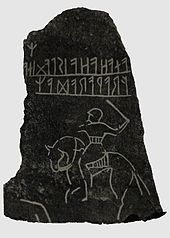
Back الشاهد القائم الروني Arabic Рунічны камень Byelorussian Рунически камък Bulgarian Pedra rúnica Catalan Runový kámen Czech Runesten Danish Runenstein German Ρουνική λίθος Greek Runŝtono Esperanto Piedra rúnica Spanish


A runestone is typically a raised stone with a runic inscription, but the term can also be applied to inscriptions on boulders and on bedrock. The tradition of erecting runestones as a memorial to dead men began in the 4th century and lasted into the 12th century, but the majority of the extant runestones date from the late Viking Age. While most of these are located in Scandinavia, particularly Sweden, there are also scattered runestones in locations that were visited by Norsemen. Runestones were usually brightly coloured when erected, though this is no longer evident as the colour has worn off.
- ^ "Om lifvet i Sverige under hednatiden" by Oscar Montelius (1905), pp. 81–82.
© MMXXIII Rich X Search. We shall prevail. All rights reserved. Rich X Search